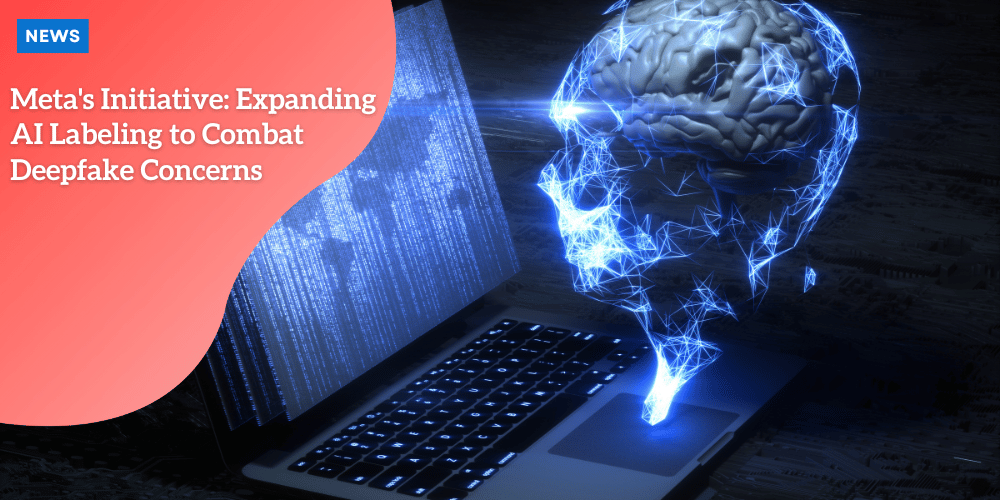Meta’s Initiative: Expanding AI Labeling to Combat Deepfake Concerns

Introduction
In today’s rapidly evolving technological landscape, the line between authentic and synthetic media is becoming increasingly difficult to distinguish.
Anúncios
This growing challenge has led to an increased focus on the role of artificial intelligence (AI) in media creation, particularly when it comes to the manipulation of digital content.
As AI capabilities advance, the ability to produce highly realistic yet entirely fabricated media—such as deepfakes and AI-generated images and videos—has surged, raising significant concerns about the integrity of information consumed by the public.
In response to these challenges, Meta (formerly Facebook) has launched a strategic initiative to expand AI labeling across its social media platforms.
Anúncios
The decision to enhance transparency through AI-generated media labels is both timely and critical, given the rising sophistication of AI-driven misinformation and deepfakes.
This policy adjustment arrives at a pivotal moment, with the 2024 presidential elections on the horizon, and emphasizes the importance of securing democratic processes in the digital age.
Meta’s Enhanced AI Labeling Strategy
Meta’s decision to bolster its AI labeling efforts reflects its commitment to maintaining transparency and empowering users to identify AI-generated content.
Anúncios
The company is rolling out a new policy that introduces “Made with AI” labels to distinguish content created through artificial intelligence.
These labels will begin to appear in March 2025 and will be applied not only to videos but also to audio recordings and still images, ensuring that a wide range of digital media can be clearly marked for the benefit of users.
This move represents a crucial step forward in Meta’s ongoing efforts to tackle the spread of manipulated content across its platforms, which have become breeding grounds for misinformation.
The expansion of AI labeling comes in response to significant public scrutiny, particularly following the dissemination of a manipulated video that featured President Biden.
The video, which was created using AI techniques, went undetected under Meta’s previous policies.
This event served as a wake-up call for the company, leading to a reassessment of its approach to moderating AI-generated content.
The updated labeling system is designed to inform users that they are encountering media created or altered by AI, offering them an opportunity to critically evaluate the content and make more informed decisions about its authenticity.
Significance of Addressing Deepfake Concerns and AI-generated Misinformation
The proliferation of deepfake technology and AI-generated misinformation poses a grave threat to the trustworthiness of information in the digital era.
Deepfakes—videos, images, or audio recordings that manipulate or replace the likeness or voice of a person—are becoming increasingly sophisticated, making it nearly impossible for the average user to discern truth from fiction.
AI algorithms can now craft media that is indistinguishable from authentic recordings, amplifying the potential for manipulation, especially in the context of political discourse, elections, and other high-stakes public events.
Meta’s decision to label AI-generated media reflects the growing recognition of the dangers posed by such technological advancements.
By clearly marking content that has been generated or altered through artificial intelligence, the company seeks to provide users with a valuable tool for navigating the ever more complex digital information landscape.
This initiative is crucial in a time when misinformation, particularly in the form of deepfakes, can spread quickly and influence public opinion, creating confusion, polarization, and distrust.
Contextual Relevance of the 2024 Presidential Elections
The timing of Meta’s expanded AI labeling strategy is particularly significant in light of the upcoming 2024 U.S. presidential elections.
Historically, election cycles have been vulnerable to the spread of false or misleading information, with social media platforms playing a pivotal role in the dissemination of both truthful and fabricated narratives.
AI technologies, particularly deepfakes, have the potential to exacerbate these vulnerabilities, enabling the rapid spread of misinformation designed to manipulate public opinion or influence election outcomes.
Given the stakes of the 2024 elections, Meta’s updated policy on AI labeling is a timely response to the growing concerns over election integrity.
By introducing labels to indicate AI-generated content, Meta aims to reduce the risk of disinformation campaigns using AI-driven media to influence voters.
The platform’s proactive approach seeks to preserve the credibility of the electoral process and safeguard democratic principles, reinforcing the importance of transparency and authenticity in political discourse.
Meta’s Previous Approach to Manipulated Media
Prior to the introduction of the expanded AI labeling initiative, Meta’s approach to dealing with manipulated media primarily focused on identifying and removing videos that had been altered or fabricated.
The platform utilized AI-driven detection tools to flag and take down content that violated its policies, particularly regarding fake or misleading videos.
However, as AI technologies advanced, the scope of potential manipulation widened.
Deepfakes and AI-generated content now extend beyond video, encompassing audio recordings and even still images, rendering Meta’s previous framework insufficient in addressing the full spectrum of digital manipulation.
The company’s previous policies were largely reactive, focusing on removing problematic content after it had been published.
This approach proved inadequate in keeping up with the rapid pace of technological innovation and the growing sophistication of digital media manipulation.
Meta’s oversight board, an independent group that reviews content moderation decisions, criticized the company for its narrow approach to manipulated media, highlighting the need for a broader, more proactive strategy.
The resulting policy overhaul reflects Meta’s acknowledgment that more comprehensive measures are necessary to effectively combat AI-generated misinformation.
Critique from the Oversight Board and Policy Reform
Meta’s approach to manipulated media faced intense scrutiny following the circulation of a deepfake video featuring President Biden, which evaded detection under the company’s existing policies.
In response to the Oversight Board’s critique, Meta’s Vice President of Content Policy, Monika Bickert, publicly acknowledged that the company’s previous framework was inadequate in addressing the growing issue of AI-generated media.
The Oversight Board pointed out that Meta’s focus on video manipulation was too limited, as the rise of AI-generated content in other formats, such as audio and still images, was equally concerning.
As a result of this feedback, Meta initiated a significant policy shift.
Moving forward, the company will not only label AI-generated content but will also refrain from removing such media unless it violates specific rules, such as inciting violence or spreading harmful disinformation.
This shift reflects Meta’s commitment to balancing transparency with free expression, as the company recognizes that the mere act of labeling content may not be sufficient to combat the dangers posed by AI manipulation.
By labeling rather than removing content, Meta aims to foster a more informed and critical user base, while also respecting freedom of speech.
Challenges and Considerations in Labeling AI-generated Content
Despite its potential to combat misinformation, Meta’s AI labeling initiative faces several challenges.
One of the key concerns is the efficacy of labeling as a standalone measure.
AI-generated content can be highly sophisticated, and detecting such media is not always straightforward.
While the “Made with AI” labels may help users identify manipulated content, there is a risk of “label blindness,” where users may dismiss the labels or fail to notice them altogether.
Additionally, the speed at which AI technologies evolve means that detection tools will need to be constantly updated to keep pace with new forms of media manipulation.
Another challenge is the potential for labeling to be ineffective in curbing the spread of misinformation.
Labeling content may raise awareness, but it does not necessarily prevent the content from being shared, viewed, or believed.
As a result, there is a need for more comprehensive solutions that involve both technological advancements in AI detection and broader efforts to promote digital literacy among users.
Educating the public on how to recognize and critically evaluate AI-generated content is an essential component of the broader strategy to combat misinformation.
Future Implications and Collaborative Endeavors
The future of AI labeling and misinformation detection will depend on collaboration and innovation across the tech industry.
Meta’s expanded AI labeling initiative is a step in the right direction, but it will need to be part of a larger, collective effort to address the challenges posed by AI-generated content.
Collaborative partnerships between tech companies, governments, and independent organizations will be necessary to develop more robust detection mechanisms and to ensure that AI-generated content is effectively flagged and monitored across platforms.
Moreover, regulatory frameworks will play an important role in shaping the future of digital media.
Governments around the world are beginning to recognize the importance of regulating AI-generated content to protect users from the dangers of misinformation.
As these regulatory frameworks evolve, they will likely complement efforts by platforms like Meta to label and moderate AI-generated content.
Conclusion
In conclusion, Meta’s expansion of AI labeling marks a significant step toward increasing transparency and accountability in the digital media landscape.
By labeling AI-generated content, the company seeks to empower users to make more informed decisions about the information they consume.
However, labeling alone will not be sufficient to address the complex challenges posed by deepfakes and AI-driven misinformation.
It will require a combination of technological innovation, digital literacy initiatives, and collaborative efforts across the tech industry to mitigate the risks associated with synthetic media.
As we move into an era where AI plays an increasingly dominant role in content creation, it is crucial that we prioritize transparency, authenticity, and the integrity of information to protect the fundamental principles of democracy and trust in the digital age.





